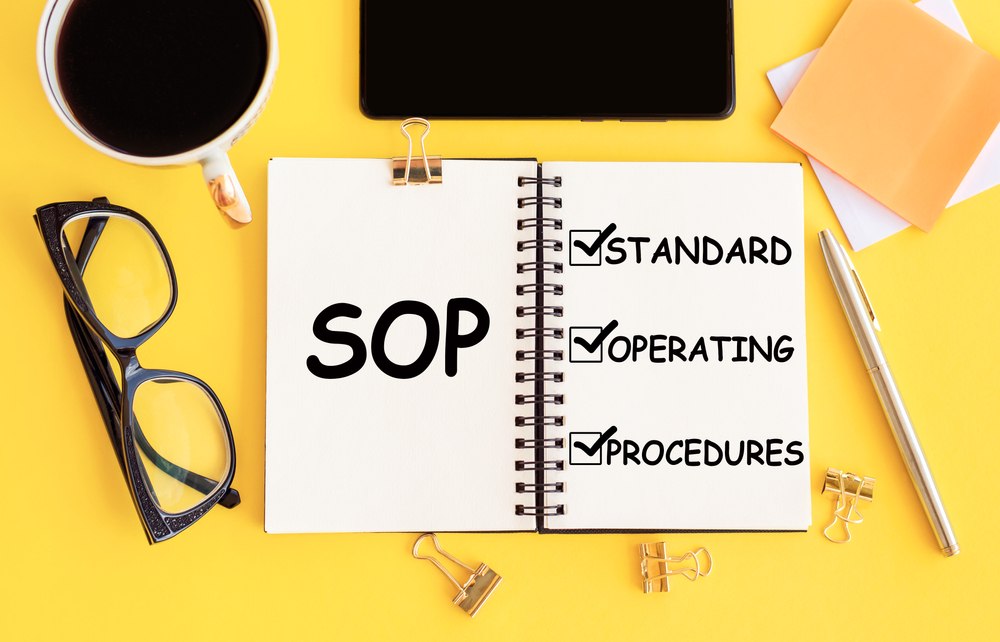Businesses adopt different practices to meet quality standards within their organization. One such practice is the standard operating procedure, which effectively documents your standards and policies to convey ideas quickly. So, in this article, we will understand the standard operating procedure definition in detail by shedding light on its benefits, types, and writing steps.
What is Standard Operating Procedure?
A standard operating procedure is a written guideline for completing a task in an industry and business environment. Plus, it is a step-by-step instruction to bring consistency to work. These standards, policies, and instructions are needed in your business’s operation to meet specified standards. Subsequently, the abbreviation for the standard operating procedure is SOP, which is usually used in official documents of guidelines, standards, and policies.
The standard operating procedure differentiates one company’s business practices from another. It helps establish a branch of your company in other cities with the same standard and quality. Also, it is a way to train new employees on specific tasks, procedures, and equipment. Besides, these instructions reduce miscommunication and failure by providing uniformity.
Benefits of Standard Operating Procedure (SOP)
The standard operating procedure definition says that these are rules to ensure that things go the right way. You can make your business profitable by following these instructions. Additionally, your business keeps working smoothly with these established standards. So, there are some other benefits of standard operating procedures that we discussed below:
- Risk Management: There are many potential risks in different processes of industry. The standard operating procedure helps to recognize and mitigate the risks to avoid adverse effects.
- Accountability: These procedures let team members know what is expected from them. Therefore, it establishes accountability by defining rules and regulations.
- Customer Satisfaction: SOP standard operating procedure satisfies the customer by ensuring a high-quality process. So, they rely easily on services or products that fulfill specific standards.
- Compliance: These specified instructions ensure compliance with industry standards. Additionally, a documented procedure like this avoids legal and monitoring-related issues.
Types of Standard Operating Procedure
Every business has its requirements and standards for regulations. So, the point is how to write a standard operating procedure differently for different needs. For this, many types of standard operating procedures are suited for certain types of business requirements. The types of SOPs can be simple documents like PDFs and Word to represent the process.
In addition, some are in the form of flowcharts and diagrams to explain the instructions more systematically. These instructions or guidelines can be easily memorized by incorporating them in Checklist form. In addition, these standard operating procedures offer several options for documenting the instructions efficiently.
Formats of Standard Operating Procedure
There are many formats for writing down the instructions and regulations in an organized way. You can choose a particular format to fulfill your purpose, depending on your requirements. These formats have been discussed below to help you understand them better.
1. Checklist
The most straightforward format of the SOP standard operating procedure is a checklist. The note-taking apps enable users to create a to-do list. Employees can receive a printed copy individually for their professional training. So, this tool ensures accountability for meeting expectations and serves as a convenient method to verify that tasks are performed accurately by team members.
2. Step-by-Step List
A step-by-step list is another easy way to describe the procedure in bullet points. These points help the person to follow guidelines one by one to perform tasks efficiently. The complex instructions become organized and easy to follow in this standard operating procedure format. Also, this list helps ensure that your team member’s task is done more systematically.
3. Hierarchical Lists
Some procedures or guidelines have additional information that needs an ordered structure. This can happen by creating hierarchical lists of the instructions. It helps to explain the rules and regulations that are hard to explain in a single step. Besides that, a lengthy list of instructions gives a boring look to the standard operating procedure format. So, these hierarchical lists make instructions short and interesting for those who want to follow them.
4. Process Flowchart
Process flowcharts make using the equipment with specified instructions in an industrial environment easy. This standard operating procedure format helps the workers of the industry to understand the working process of equipment visually. Additionally, it helps to give the context to the reader to understand the guidelines clearly. So, it conceptualizes the whole concept for workers by relating one step to another.
How to Write a Standard Operating Procedure
It is essential to understand how to write a standard operating procedure for better application. The following steps will help you effectively represent your plans and thoughts on specific guidelines. These steps are discussed below to standardize the procedure:
1. Define the Scope of End User Problem
The first step in the SOP documentation is to describe the scope to solve the end user’s problem. This step gives the main theme for writing the document of standard operating procedure. If you want to create instructions for providing service to the potential client, it becomes easy to get an idea of the title. The document then needs to have all details of that specified scope or problem of the end user.
2. Gather the Required Information
After defining the scope, the next step is collecting relevant information regarding the end user’s problem. The information-gathering process is crucial in documenting the standard operating procedure step as it tells what needs to be organized. Moreover, this step gives the required content for the document on standard operating procedure.
3. Choose the Right Format
Once you have the proper information, decide on the right standard operating procedure format according to the information. For this purpose, the detailed information must be in a flowchart or hierarchical format. At the same time, easy information should be documented in the SOP checklist format.
4. Make an Outline for SOP
The outline-making step of the SOP standard operating procedure makes it easy to understand what we need to document. This step of the standard operating procedure writing document highlights essential points. You can follow the outline given below to kick-start your documentation process:
- Title Page
- Table of Contents
- Introductory Information
- Procedures and the Methodology
- Quality Control and Quality Assurance
- References and Glossary
5. Write the Document
After following the above steps, write the content in the SOP document. You can use the help of the AI tools to aid in the documentation process. Docuo is one such tool that helps in writing the document automatically from the generated code or AI-integrated system. Also, it helps in abbreviating, correcting, and refining the document content more easily.

6. Review and Make Changes
You can make your SOP document error by reviewing it properly. This helps in finding the mistakes that need to be improved before finalization. You can amend the inaccuracy and inconsistency in the standard operating procedure document to make it perfect. Moreover, this error-free document delivers the idea more effectively after validation from the experts.
Challenges of Standard Operating Procedure (SOP)
Companies can implement consistency and efficiency in the workflow through standard operating procedures. However, they may face some challenges that should be addressed to ensure the effectiveness of SOP in the organizational process. The common challenges of standard operating procedures are discussed below to get an idea of them.
1. Lack of Training
Sometimes, improper training of employees creates a challenge to adhere to the procedures. Employees have SOPs in proper structure form but do not have the skills to implement them properly. So, it will create problems in working as employees have instructions without knowing what to do with this guideline. Other than that, this lack of employee training can create some workplace risks.
2. Inadequate Communication
The workplace needs may prompt updates to the content and standard operating procedure format. However, inadequate communication among team members could hinder the delivery of this updated information. The workers in the workplace used the old instructions for operating equipment, causing potential risk. This simple challenge can create problems despite the SOP document.
3. Failure to Apply Compliance
Only the SOP documentation is not enough to ensure consistency in the workplace. Enforcement of compliance is also essential to get actual benefits from the standard instructions. So, failure to enforce compliance becomes another challenge in regulating standard operating procedures.
4. Improper Documentation
The changes and updates in SOP standard operating procedures may happen frequently. Frequent changes may inadequately document these changes due to their frequency. This poorly documented SOP does not deliver the instructions clearly to the people. In addition, inadequate documentation lacks details that create an issue in understanding the required instruction or point.
Why Docuo for Standard Operating Procedures?
SOP standard operating procedures have some challenges that cause problems for not delivering regulations properly. There is a need for a tool that helps in writing the SOP document without any gaps or inaccuracies. The AI-empowered Docuo tool allows us to write standard operating procedures without any mistakes and much effort.

Docuo is an all-in-one innovative documentation platform that helps write and publish content. It is a powerful tool to elevate the capability of the writing team. Also, this AI tool removes the fragmented workflow and combines the tasks to enhance the efficiency of the document. Additionally, certain features of this fantastic tool discussed below make it more operative and easier to use.
- Document Generation With the Help of the Code
- Simplify the Code Added in the Document
- AI Writing Co-pilot
- Improve Writing by Correcting and Refining the Content
- Directory Generation with the Power of AI
Read more:


